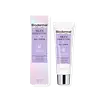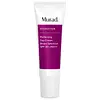What's inside
What's inside
 Key Ingredients
Key Ingredients

 Benefits
Benefits

 Concerns
Concerns

 Ingredients Side-by-side
Ingredients Side-by-side

Water
Skin ConditioningNiacinamide
SmoothingEthylhexyl Salicylate
UV AbsorberDibutyl Adipate
EmollientDiisopropyl Sebacate
EmollientGlycerin
HumectantPropanediol
SolventTris-Biphenyl Triazine
UV AbsorberDimethicone
EmollientCetyl Dimethicone
EmollientEthylhexyl Triazone
UV AbsorberBis-Ethylhexyloxyphenol Methoxyphenyl Triazine
Skin ConditioningDiethylamino Hydroxybenzoyl Hexyl Benzoate
UV FilterTapioca Starch
Bis-PEG/PPG-20/5 PEG/PPG-20/5 Dimethicone
EmulsifyingMethoxy PEG/PPG-25/4 Dimethicone
EmulsifyingSilica
AbrasiveMethylene Bis-Benzotriazolyl Tetramethylbutylphenol
UV FilterDiethylhexyl Carbonate
EmollientAscorbyl Tetraisopalmitate
AntioxidantTocopheryl Acetate
AntioxidantHydrolyzed Hyaluronic Acid
HumectantSarcosine
Skin ConditioningHydroxyacetophenone
AntioxidantDecyl Glucoside
CleansingCaprylic/Capric Triglyceride
MaskingButylene Glycol
HumectantAcrylates/C10-30 Alkyl Acrylate Crosspolymer
Emulsion StabilisingAmmonium Acryloyldimethyltaurate/Vp Copolymer
Cetearyl Alcohol
EmollientPentylene Glycol
Skin ConditioningXanthan Gum
EmulsifyingPolysorbate 80
EmulsifyingPropylene Glycol
HumectantDisodium Phosphate
BufferingCitric Acid
BufferingPentaerythrityl Tetra-Di-T-Butyl Hydroxyhydrocinnamate
AntioxidantPhenoxyethanol
PreservativeParfum
MaskingWater, Niacinamide, Ethylhexyl Salicylate, Dibutyl Adipate, Diisopropyl Sebacate, Glycerin, Propanediol, Tris-Biphenyl Triazine, Dimethicone, Cetyl Dimethicone, Ethylhexyl Triazone, Bis-Ethylhexyloxyphenol Methoxyphenyl Triazine, Diethylamino Hydroxybenzoyl Hexyl Benzoate, Tapioca Starch, Bis-PEG/PPG-20/5 PEG/PPG-20/5 Dimethicone, Methoxy PEG/PPG-25/4 Dimethicone, Silica, Methylene Bis-Benzotriazolyl Tetramethylbutylphenol, Diethylhexyl Carbonate, Ascorbyl Tetraisopalmitate, Tocopheryl Acetate, Hydrolyzed Hyaluronic Acid, Sarcosine, Hydroxyacetophenone, Decyl Glucoside, Caprylic/Capric Triglyceride, Butylene Glycol, Acrylates/C10-30 Alkyl Acrylate Crosspolymer, Ammonium Acryloyldimethyltaurate/Vp Copolymer, Cetearyl Alcohol, Pentylene Glycol, Xanthan Gum, Polysorbate 80, Propylene Glycol, Disodium Phosphate, Citric Acid, Pentaerythrityl Tetra-Di-T-Butyl Hydroxyhydrocinnamate, Phenoxyethanol, Parfum
Butyl Methoxydibenzoylmethane
UV AbsorberHomosalate 2%
Skin ConditioningEthylhexyl Methoxycinnamate 7.5%
UV AbsorberEthylhexyl Salicylate 5%
UV AbsorberBenzophenone-3 4%
UV AbsorberWater
Skin ConditioningButylene Glycol
HumectantPentylene Glycol
Skin ConditioningGlyceryl Stearate
EmollientPEG-100 Stearate
Diisopropyl Sebacate
EmollientIsodecyl Neopentanoate
EmollientLauryl Lactate
EmollientStearic Acid
CleansingSorbitan Stearate
EmulsifyingUrea
BufferingYeast Amino Acids
HumectantTrehalose
HumectantInositol
HumectantTaurine
BufferingBetaine
HumectantPhospholipids
Skin ConditioningRetinyl Palmitate
Skin ConditioningTocopheryl Acetate
AntioxidantAscorbyl Palmitate
AntioxidantCetearyl Alcohol
EmollientCeteareth-20
CleansingCitrus Medica Limonum Peel Extract
EmollientCalendula Officinalis Flower Extract
MaskingGlycolipids
Skin ConditioningSodium Hyaluronate
HumectantLecithin
EmollientTocopherol
AntioxidantHydrogen Peroxide
AntimicrobialDipotassium Glycyrrhizate
HumectantPunica Granatum Extract
AstringentMagnesium Ascorbyl Phosphate
AntioxidantHydrolyzed Soy Flour
Skin ConditioningAvena Sativa Kernel Protein
Skin ConditioningPalmitoyl Hydroxypropyltrimonium Amylopectin/Glycerin Crosspolymer
Skin ConditioningVitis Vinifera Seed Extract
AntimicrobialCamellia Sinensis Leaf Extract
AntimicrobialOenothera Biennis Oil
EmollientBorago Officinalis Seed Oil
EmollientSodium PCA
HumectantDimethicone
EmollientPropylene Glycol
HumectantCarbomer
Emulsion StabilisingSclerotium Gum
Emulsion StabilisingAminomethyl Propanol
BufferingChlorphenesin
AntimicrobialPhenoxyethanol
PreservativeMethylparaben
PreservativePropylparaben
PreservativeDisodium EDTA
Linalool
PerfumingLavandula Angustifolia Oil
MaskingButyl Methoxydibenzoylmethane, Homosalate 2%, Ethylhexyl Methoxycinnamate 7.5%, Ethylhexyl Salicylate 5%, Benzophenone-3 4%, Water, Butylene Glycol, Pentylene Glycol, Glyceryl Stearate, PEG-100 Stearate, Diisopropyl Sebacate, Isodecyl Neopentanoate, Lauryl Lactate, Stearic Acid, Sorbitan Stearate, Urea, Yeast Amino Acids, Trehalose, Inositol, Taurine, Betaine, Phospholipids, Retinyl Palmitate, Tocopheryl Acetate, Ascorbyl Palmitate, Cetearyl Alcohol, Ceteareth-20, Citrus Medica Limonum Peel Extract, Calendula Officinalis Flower Extract, Glycolipids, Sodium Hyaluronate, Lecithin, Tocopherol, Hydrogen Peroxide, Dipotassium Glycyrrhizate, Punica Granatum Extract, Magnesium Ascorbyl Phosphate, Hydrolyzed Soy Flour, Avena Sativa Kernel Protein, Palmitoyl Hydroxypropyltrimonium Amylopectin/Glycerin Crosspolymer, Vitis Vinifera Seed Extract, Camellia Sinensis Leaf Extract, Oenothera Biennis Oil, Borago Officinalis Seed Oil, Sodium PCA, Dimethicone, Propylene Glycol, Carbomer, Sclerotium Gum, Aminomethyl Propanol, Chlorphenesin, Phenoxyethanol, Methylparaben, Propylparaben, Disodium EDTA, Linalool, Lavandula Angustifolia Oil
Ingredients Explained
These ingredients are found in both products.
Ingredients higher up in an ingredient list are typically present in a larger amount.
Butylene Glycol (or BG) is used within cosmetic products for a few different reasons:
Overall, Butylene Glycol is a safe and well-rounded ingredient that works well with other ingredients.
Though this ingredient works well with most skin types, some people with sensitive skin may experience a reaction such as allergic rashes, closed comedones, or itchiness.
Learn more about Butylene GlycolCetearyl alcohol is a mixture of two fatty alcohols: cetyl alcohol and stearyl alcohol. It is mainly used as an emulsifier. Emulsifiers help prevent the separation of oils and products. Due to its composition, it can also be used to thicken a product or help create foam.
Cetearyl alcohol is an emollient. Emollients help soothe and hydrate the skin by trapping moisture.
Studies show Cetearyl alcohol is non-toxic and non-irritating. The FDA allows products labeled "alcohol-free" to have fatty alcohols.
This ingredient is usually derived from plant oils such as palm, vegetable, or coconut oils. There is debate on whether this ingredient will cause acne.
Due to the fatty acid base, this ingredient may not be Malassezia folliculitis safe.
Learn more about Cetearyl AlcoholWe don't have a description for Diisopropyl Sebacate yet.
Dimethicone is a type of synthetic silicone created from natural materials such as quartz.
What it does:
Dimethicone comes in different viscosities:
Depending on the viscosity, dimethicone has different properties.
Ingredients lists don't always show which type is used, so we recommend reaching out to the brand if you have questions about the viscosity.
This ingredient is unlikely to cause irritation because it does not get absorbed into skin. However, people with silicone allergies should be careful about using this ingredient.
Note: Dimethicone may contribute to pilling. This is because it is not oil or water soluble, so pilling may occur when layered with products. When mixed with heavy oils in a formula, the outcome is also quite greasy.
Learn more about DimethiconeEthylhexyl Salicylate is an organic compound used to block UV rays. It primarily absorbs UVB rays but offers a small amount of UVA protection as well.
Commonly found in sunscreens, Ethylhexyl Salicylate is created from salicylic acid and 2-ethylhexanol. You might know salicylic acid as the effective acne fighter ingredient and BHA.
The ethylhexanol in this ingredient is a fatty alcohol and helps hydrate your skin, similar to oils. It is an emollient, which means it traps moisture into the skin.
According to manufacturers, Ethylhexyl Salicylate absorbs UV wavelength of 295-315 nm, with a peak absorption at 307-310 nm. UVA rays are linked to long term skin damage, such as hyperpigmentation. UVB rays emit more energy and are capable of damaging our DNA. UVB rays cause sunburn.
Learn more about Ethylhexyl SalicylatePentylene glycol is typically used within a product to thicken it. It also adds a smooth, soft, and moisturizing feel to the product. It is naturally found in plants such as sugar beets.
The hydrophilic trait of Pentylene Glycol makes it a humectant. As a humectant, Pentylene Glycol helps draw moisture from the air to your skin. This can help keep your skin hydrated.
This property also makes Pentylene Glycol a great texture enhancer. It can also help thicken or stabilize a product.
Pentylene Glycol also acts as a mild preservative and helps to keep a product microbe-free.
Some people may experience mild eye and skin irritation from Pentylene Glycol. We always recommend speaking with a professional about using this ingredient in your routine.
Pentylene Glycol has a low molecular weight and is part of the 1,2-glycol family.
Learn more about Pentylene GlycolPhenoxyethanol is a preservative that has germicide, antimicrobial, and aromatic properties. Studies show that phenoxyethanol can prevent microbial growth. By itself, it has a scent that is similar to that of a rose.
It's often used in formulations along with Caprylyl Glycol to preserve the shelf life of products.
Propylene Glycol is an odorless, colorless liquid. As a humectant, it helps skin retain moisture. It also aids in delivering active ingredients.
Another role of this ingredient is preventing a product from melting or freezing. Propylene glycol also adds antimicrobrial properties to a product, elongating product lifespan.
This ingredient is considered an organic alcohol and commonly added into both cosmetics and foods.
Those with sensitive skin or conditions may develop a rash when using this ingredient.
Learn more about Propylene GlycolTocopheryl Acetate is AKA Vitamin E. It is an antioxidant and protects your skin from free radicals. Free radicals damage the skin by breaking down collagen.
One study found using Tocopheryl Acetate with Vitamin C decreased the number of sunburned cells.
Tocopheryl Acetate is commonly found in both skincare and dietary supplements.
Learn more about Tocopheryl AcetateWater. It's the most common cosmetic ingredient of all. You'll usually see it at the top of ingredient lists, meaning that it makes up the largest part of the product.
So why is it so popular? Water most often acts as a solvent - this means that it helps dissolve other ingredients into the formulation.
You'll also recognize water as that liquid we all need to stay alive. If you see this, drink a glass of water. Stay hydrated!
Learn more about Water